8 parade-worthy classic cars under $25,000
I love a parade, the tramping of feet,
I love every beat I hear of a drum.
I love a parade, when I hear a band
I just want to stand, and cheer as they come!
Say, that sounds like Harry Richman, a popular singer who was stuck loving parades in every show he did for the next two decades after I Love a Parade became a smash hit in 1932.
Know who else loves a parade? We do. Especially small-town ones, with classic cars following along behind the local police chief and some firemen on an old-time (red) fire truck with a Dalmatian (black and white).
When it comes to parade cars, the more varied they are, the better. Here are eight classics we’d love to see in a parade. Why, we’d stand and cheer as they came. Built before 1950, they’re all under $25,000, per Hagerty’s valuation experts. Prices are for number 3, or good, condition vehicles. (Want the full run-down on our 1-to-4 scale? Click here.)
1911 Ford Model T Open Runabout, $23,400
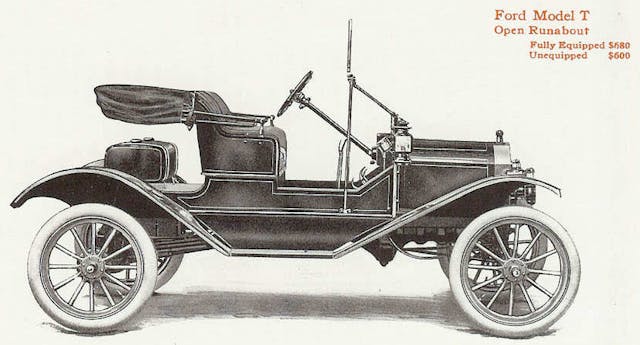
There’s nothing like the obligatory Model T, sold by Ford for 18 years with only basic changes. That said, 1911 saw mildly significant updates, with top, windshield, side curtains, and gas lamps for the convertible. “High-priced quality in a low-priced car,” Ford claimed. The standard color was Royal Blue, often with pinstripes (this was seven years before Henry Ford’s pronouncement that you could have any color you wanted, so long it was black). “Fully equipped,” said one ad from the times, for $680. Power is from the 20-horsepower four-cylinder engine. A T would be the perfect parade car for a high-school homecoming queen, who can do the cupped-hand “Princess Diana” wave from the right seat.
1947 Willys-Jeep CJ 2A, $13,600

Put the town’s oldest veteran in this Willys-Jeep CJ 2A, only a few years removed from the World War II era that spawned the military Jeep. There are only modest changes between that Willys-Jeep and this one. In fact, many out there are painted drab green in commemoration, with serial numbers stenciled on the hood, American flags flying from the front bumper.
CJ, of course, stood for “civilian Jeep,” a name that lasted from one manufacturer to another from 1945 until 1986, when it was replaced by the Jeep Wrangler in 1987. A total of 214,760 CJ-2As were produced, powered by the bulletproof 2.2-liter Willys Go-Devil engine.
1935 Auburn Supercharged sedan, $24,000
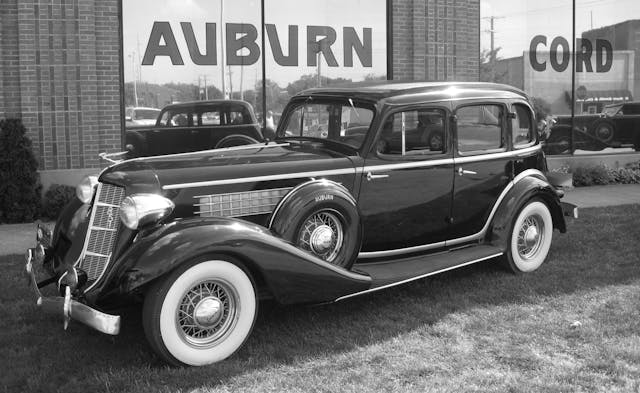
Yes, of course, Auburn is best known for its ultra-collectible 851 Supercharged Speedster, but that car blows our $25,000 price cap out of the water by about $767,000. That doesn’t mean the Supercharged Sedan isn’t a nice car. Plus, you can tell people you own a model that has some bits and pieces that sold for over $1 million, including the supercharged engine, which the Sedan was shared with the Speedster. The former still wears Auburn’s characteristically flowing mid-1930s sheetmetal, albeit without the boattail, and the elegant design should draw attention in any parade.
1946 Fiat Topolino, $22,100
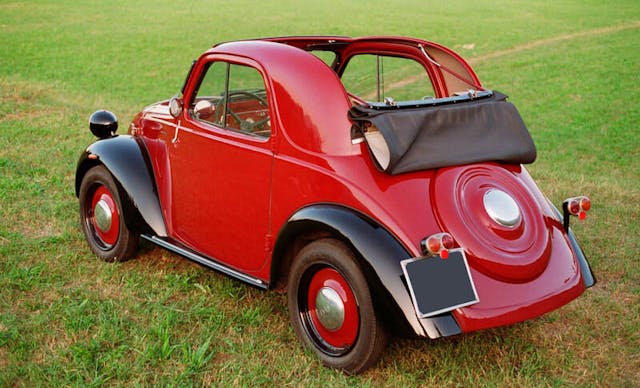
“Cute” cars always carry their weight in a parade, and they don’t come much cuter than the Topolino. With headlights that resemble mouse ears, it’s no wonder the Topolino has a name that translates to “little mouse” in Italian. Essentially a Fiat 500, the tiny Topolino looked and acted like a big car shrunk down, which is what many buyers wanted in the dawning era of the Volkswagen Beetle. Fiat recently resurrected the name for a teeny tiny, electric quadricycle; between the two, we’ll go old-school.
1927 Chrysler Series 60 roadster, $21,800
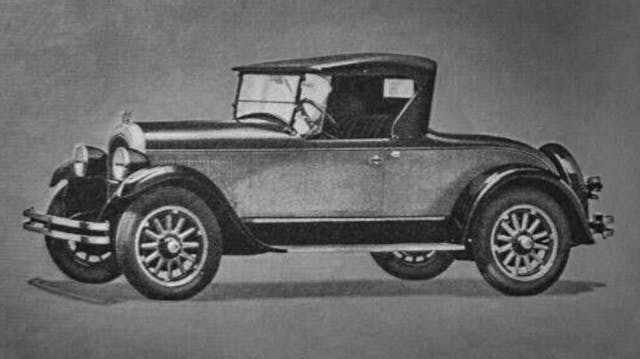
How about some relatively rare American iron? The Chrysler 60 Series debuted in 1927 as a roadster, sedan, landaulet, coupe, or touring car. We’ll take the 3.0-liter six-cylinder-powered roadster, because it gives local dignitaries proper visibility to wave at the crowd. As its name suggests, the car would exceed 60 mph–but hopefully not in a parade.
1948 Riley Roadster, $23,600
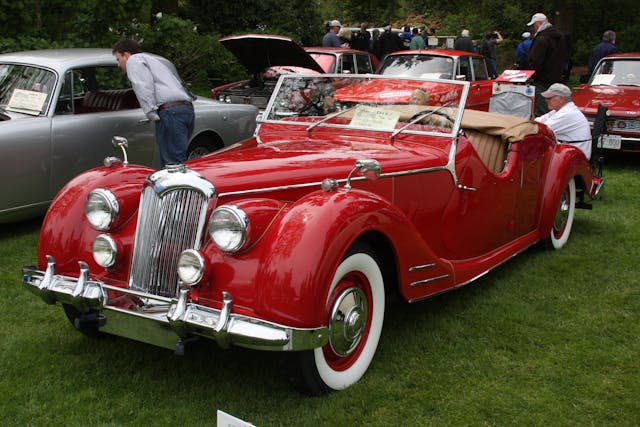
Perhaps just as rare as the 60 Series is the British 1948 Riley Roadster, a two-door, two- or three-seat convertible that’s unmistakably British. Sort of a cross between a sports car and a regular cabriolet, the Riley Roadster was targeted at the North American market. Powered by a 2.6-liter four-cylinder with a column-mounted shifter, it was capable of speeds up to 100 mph. Just over 500 were built before production ended in 1951.
1940 Chevrolet Model K Suburban, $24,900

The Suburban has been around serving roughly the same market segment since 1935. We’re picking the 1940 version, built during wartime, and the last model from Generation 1 (we’re up to 12 as of 2023). Power came from the venerable Stovebolt six-cylinder. There was seating for up to eight—three up front, two in the middle, three out back. After all, no parade is complete without clowns or a brass band, and they need transportation, too!
1949 Crosley Hot Shot, $14,800

Cute, part two. The cheerful-looking Crosley Hot Shot was the American equivalent of the MG- and Triumph-type roadsters that appealed to American soldiers serving in Europe during World War II. Back home, Powel Crosley, Jr. of the Crosley Radio Corporation and Crosley Motors, developed what is regarded as America’s first postwar sports car, the 1949 Crosley Hot Shot. It was powered, if you can call it that, by a 26-horsepower, 44-cubic-inch four-cylinder, but it was cheap at just $849. Only 2500 were built, but maybe you can find one to star in your hometown parade.
***
Check out the Hagerty Media homepage so you don’t miss a single story, or better yet, bookmark it. To get our best stories delivered right to your inbox, subscribe to our newsletters.
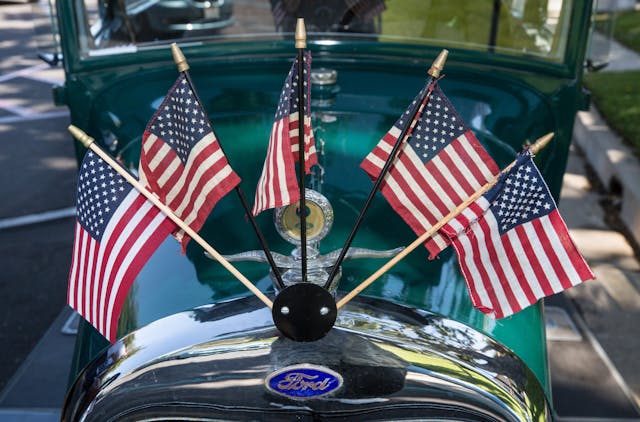


Could not find 1935 Auburn Supercharged sedan for sale anywhere on internet. Where is the car in the article located and name of dealer?
you forgot the Nissan Figaro. it’s a sub 20k very limited convertible that is easy to own and maintain.
I think you snuck the Auburn sedan in there; the true parade car was and is the ragtop variety. If you showed and Auburn Speedster, or even factory drop-top, I’d find it more congruous with the article banner. The Suburban: you could pack it with Cub Scouts (Okay, Brownies) and be a parade hit. Just sayin’
The Auburn is a great car, but where are you finding an Auburn under 25k?!
I third that – I’ve been following the ACD market fairly closely and I haven’t seen anything resembling the car suggested at any price. Even the non-supercharged sedans in nice sorted condition seem to be over 50K.
just working off the list they gave me. i was surprised at the price, too, but there were several auburns on the list.
I’ll take the Jeep hands down. We used them at work in the 60’s. Almost indestructible, versatile, reliable and well built.
Chris, since people, and i’m greatly g e n e r a l i z i n g, are drawn to the cars around when they were car mad teens too young for a driver’s license, that means many of those appreciating Auburns and much else have joined their ancestors or retirement communities; “Waiting for God,” as a popular Brit sitcom about such entitled. That means real bargains. BTW, many such Auburns came with Columbia two-speed rear axle, 5:1 low range for around town flexibility, 3.5:1 for easy highway cruising. I know a 30-year-old mechanic selling a good-looking, strong running ’40 Buick Roadmaster sedan for only $20,000 because he needs the coin for impending marriage, only has room for one car, and wants to focus on rebuilding–authentically– his ’37 Dodge, retain the original drive train, no mickey mouse “retro rod” SBC/Turbo HydraMatic golf cart crapola by those who don’t anything about the cars they’re decimating, haven’t the education or cultural background to appreciate.
In other words, if you look around, you can find a good prewar show and go road car for a fraction the price of the usual “numbers matching” Camaros/Mustangs whacked out like party favors. Jerking off at stop lights in front of strangers gets old, and most vintage cars will move smartly if properly tuned, something any kid at the corner gas station used to be able to do. All you need are the shop manual and basic tools, the latter not often if you buy a good one that’s done or nearly so.
Our Plymouth Prowler cars are always a crowd favorite at Parades – our Club does 2-3 parades per year. Stack the bags of candy on the console – super easy candy throwing. Kids love the car…. FUN!
You also missed the second most common parade car next to the Corvette.
The Shriners Go Carts.
lol
Can’t believe Kyle Smith didn’t make you include Corvairs! 🙂
too new. 1949 back was the list i was given. and kyle was out racing when i wrote the story, would have used his take on the model t!
I feel any classic car/truck is good for parade duty. My ’66 Pontiac OHC 6 powered LeMANS is always ready for the task. [img]https://live.staticflickr.com/65535/53242618626_4ef6050e2b_z.jpg[/img]
My goodness, a Riley roadster. An unusual choice. I’ve had one for > 50 years. Great tour car with 24 U.S..A. gallon fuel tank and 2.5 L twin cam hemi. Last count was 475 actually built with 30 chassis numbers assigned but never built. Spares availble thru “Riley RM Club” in UK that has a well organized parts service.
Surprised to see a memorable Riley on this latest listicle. Interesting, storied cars w/ a long race history. My Miata-driving paramour saw a Riley Imp and said she wants one.
A few years ago, I was asked to drive my ’65 Mustang convertible in a local parade after I had it in a car show. Five days before the parade I was driving home after putting new tires on when the engine broke an exhaust rocker stud. I had to call the parade organizer to tell him I wouldn’t be able to drive in the parade. He wasn’t happy about it complaining he would have find a replacement at the last minute. I haven’t had another offer since.
I have a Topolino, 1947 but paid more than what you are showing. The Topolino had a 13 horse power four cylinder engine which was boosted up to 16 horse power for thew 1948 or 1950 model.
We could use Topolinos today. Few require a three-ton stupid useless vehicle to drive to Starbucks or the mall, let alone commute.
As a historian and the proud owner of a 1945 Willys MB that served overseas, I’m really disappointed by your inclusion of the Jeep CJ-2A, tarted up to look military, in this list of “classic” cars. Only minor changes from the military Jeep that was its forerunner?
Replacing the bumper and bumperettes, reworking the tailgate into a blank panel to mount the jerrycan bracket and the spare tire properly, adding the necessary hardware to install a proper rear seat, leaving off the footman handles and often the axe and shovel, skipping the work necessary to replace the headlights and taillights with correct ones, ignoring the fact that a real military Jeep has nine slots in the grille, not the seven that a CJ has, ignoring the visible driver-side location of the filler?
Really? These fake military Jeeps are a travesty and an embarrassment. You should be ashamed of yourselves.
My “parade car” is a white 2008 350 CLK convertible. Everybody knows what it is, everybody likes it. We had one city-oriented parade and I was driving the mayor. Someone along side the parade route yelled “Nice car!” and I replied “Thank you – your tax dollars at work!” Mayor was not pleased but laughed about it later. I also drove the Grand Marshall, a lovely lady of 93 years old. Her daughter rode in the back seat and commented that it wasn’t terribly comfortable. I told her that people didn’t usually buy cars like this for the back seat.